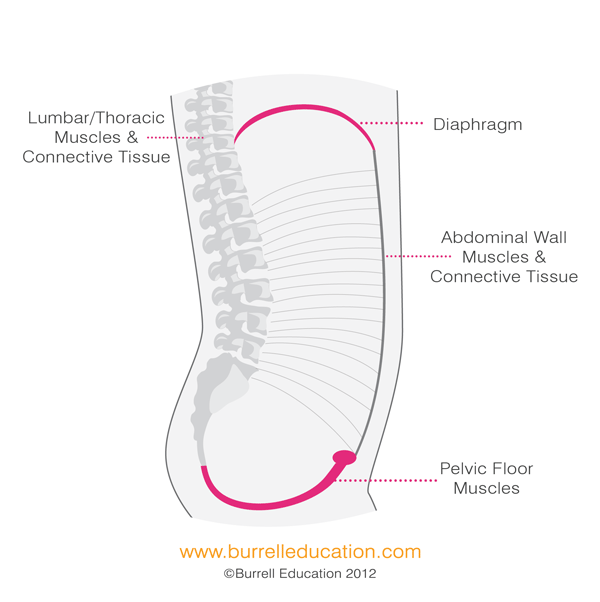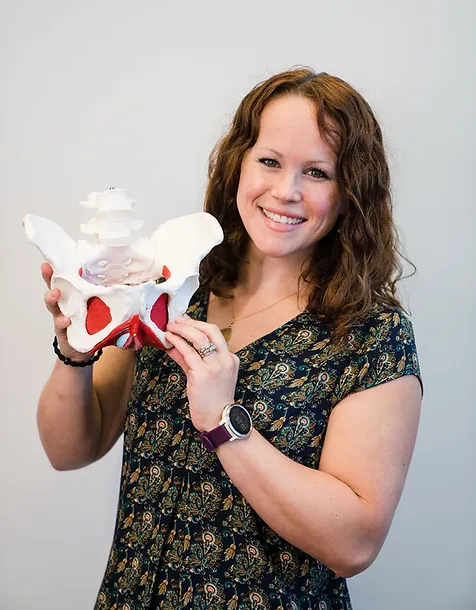Women want a strong pelvic floor. Many times, beginning pregnancy brings focus and attention to the pelvic floor, to support our growing bellies and the labor process, and foster recovery after delivery. There is controversy and confusion about kegels. How to do them? When to do them? How often? Having a healthy pelvic floor is more than just doing kegels. Having a strong pelvic floor not only means having a good contraction of the pelvic floor muscles, but also about having the ability to fully relax them, as well as having strong glute muscles, low back muscles, and deep core muscles. We need to think of our pelvic floor as more than just the “kegel muscles.” The core and pelvic floor is like a big cannister, encompassing the area from your diaphragm (rib cage area) down to the bottom of the pelvis. All of the muscles in this cannister need to work together and in coordination in order for us to have a strong foundation. When you inhale, the diaphragm drops to allow the lower lobes of the lungs to expand, the stomach muscles relax, and the pelvic floor muscles relax. When you exhale, the pelvic floor muscles gently rise as the core draws in, and the diaphragm lifts to expel the air. Diaphragmatic breathing is one of the best exercises to do during pregnancy!! Before you go to bed at night, lay on your back with your head and legs supported on pillows, knees apart in froggy or butterfly position. This position places the inner thighs and pelvic floor muscles in an open, relaxed position. Close your eyes and place your hands on your stomach. Inhale and think about breathing into your hands, or breathing down into your baby. Feel your pelvic floor muscles relax, or gently drop down. This pelvic floor relaxation is not a bearing down or pushing motion, but a gentle downward pressure, as when relaxing to urinate. As you exhale, gently contract the pelvic floor muscles and pull your belly button in towards your spine. It is imperative to feel the pelvic floor relax and contract. While we want to have a strong pelvic floor to support our organs (and help us not pee on ourselves when we cough, sneeze, or exercise!) during labor, as the baby is descending into the pelvis, the pelvic floor muscles must be able to relax and the pelvis to open for the baby to pass through the birth canal. After birth, you can start practicing your diaphragmatic breathing again to help coordinate your body after having been stretched and carrying a baby for 9 months. This breath work is a very safe and gentle exercise to start with and helps to lay the foundational strength to support healing and help you start exercising again.
Seeing a pelvic floor physical therapist after birth is a great way to make sure you are able to coordinate all of the muscle groups of your canister and correctly perform pelvic floor contractions and relaxation. If you are having any symptoms at all (urinary leakage, low back pain, pain with intercourse, prolapse, diastasis recti), please talk to your doctor! Your 6 week post-partum check-up is a great opportunity to discuss any concerns with your OBGYN. Even if you gave birth years ago, it is never too late to see a physical therapist and heal. In addition to breath work and muscle coordination practice, a pelvic floor physical therapist can perform manual therapy to address muscular pain and tension and scar tissue restrictions (C-section, vaginal scars from tearing/episiotomy), check for diastasis recti (abdominal separation) and give real time feedback to make sure you are confident with your pelvic floor activity. If your goal is to return to exercise, a physical therapist can guide you safely back into your workout routines. If you have any questions at all, please call me! Don’t suffer in silence anymore. We need to remove the shame and stigma associated with women’s health challenges and empower each other to get help and feel better.
~Dr. Steph



